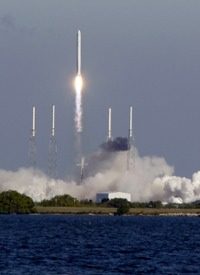
Today’s launch of SpaceX’s Falcon 9 rocket is an important development in the future of privately funded space flight. Although the Obama administration has substantially curtailed the manned space flight program proposed by his predecessor, and the future of America’s space program in a "post-shuttle" future sometimes seemed to be in doubt, SpaceX and other private space companies are demonstrating that the "Space Age" is far from over.
SpaceX has undertaken a sustained series of tests leading up to today’s successful launch. An important milestone in the process leading up to today was an earlier test in June that demonstrated the functionality of the two-stage rocket; on that occasion, the Falcon 9 did not carry an actual payload. Today’s launch included a Dragon capsule, which the corporation says could be utilized for a wide variety of applications, and will help to replace the space shuttle in the role of ferrying astronauts to the International Space Station. The privatization of space transportation means that NASA would, in essence, start purchasing tickets to orbit, rather than buying the whole means of transportation, or, as the Associated Press reported in January:
The Obama administration on Monday will propose in its new budget spending billions of dollars to encourage private companies to build, launch and operate spacecraft for NASA and others. Uncle Sam would buy its astronauts a ride into space just like hopping in a taxi.
The idea is that getting astronauts into orbit, which NASA has been doing for 49 years, is getting to be so old hat that someone other than the government can do it. It’s no longer really the Right Stuff. Going private would free the space agency to do other things, such as explore beyond Earth’s orbit, do more research and study the Earth with better satellites. And it would spur a new generation of private companies — even some with Internet roots — to innovate.
The appearance of the Falcon 9 is a dramatic contrast to the space shuttle it will be replacing. According to SpaceX, the Falcon 9 rocket is 180 feet long, which is not much shorter than the 184 feet of the space shuttle. The vast difference comes in the area of mass: at liftoff, the shuttle weighed in at 4.5 million pounds; the Falcon 9 weighs a mere 735,000 pounds. The dramatic difference is found in the different missions of the two craft: The shuttle was built to carry far larger payloads, while the lift capacity of the Falcon 9 is significantly less. The larger cargo capacity of the space shuttle was useful while construction of the international space station was underway, but the job of ferrying astronauts to and from the station requires far less capacity. As Marc Kaufman wrote for the Washington Post:
The much larger shuttle was needed to fly parts up to the $100 billion international space station, but the fleet is being retired because of its age and because its job is largely done. Each shuttle flight costs about $1 billion, while the entire NASA contribution so far to SpaceX has been $253 million, according to NASA officials.
On Monday, as the Soyuz-size rocket went through final testing, NASA officials praised the SpaceX effort as quicker and cheaper than previous NASA development projects. While the launch is several years late and over budget, the additional costs have been picked up by investors and the delay is much shorter than in previous programs.
"Both of those things are remarkable," Philip McAlister, acting director of commercial spaceflight development at NASA, said at a news briefing, "and an anomaly in terms of any historical development that I’m aware of, in terms of a traditional NASA development."
The development is an "anomaly" because the development of the Falcon 9 has been undertaken in a manner that is a dramatic contrast to the way NASA has previously operated. With private capital at risk through much of the rocket’s development, the entire approach was significantly different from the usual path of government contracts. The privatization of space flight is far from fully realized, but that goal is one step closer today.
Photo: AP Images



